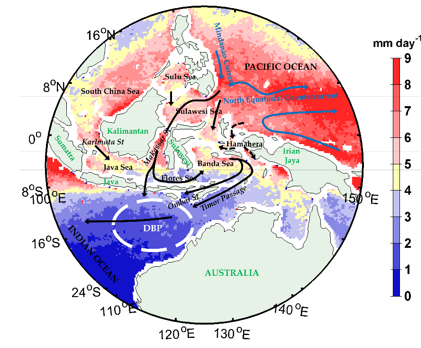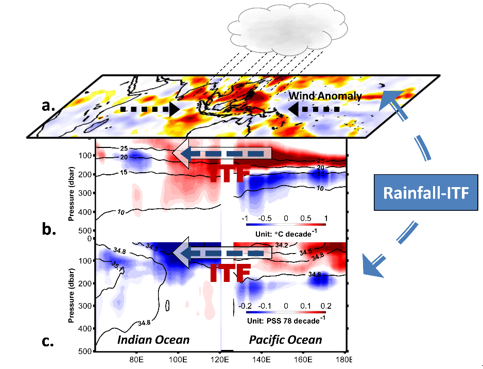The Indonesia Seas is the only oceanic pathway that connects tropical ocean basins. It contributes significant inter-basin exchange of heat and freshwater through the well-known Indonesia Throughflow (ITF, Figure 1). The ITF is typically thought to be controlled by the pressure gradient between the tropical Pacific and Indian Ocean basins. However, the role of freshwater input and salinity variability is unclear yet even if there is strong mixing and significant freshwater input.
Scientists from the Institute of Oceanology at Chinese Academy of Sciences and Scripps Institution of Oceanography, Drs Shijan Hu and Janet Sprintall, recently worked on this essential issue to better understanding the variability of the ITF and hence the tropical Indo-Pacific Ocean environment. They successfully separate the salinity effect from the density and ITF transport calculations on the basis of the DBP-ITF theory proposed by Andersson and Stigebrandt (2005).
They find that salinity effect contributes (36±7)% of the total interannual variability of ITF, which is mainly related to the El Ni?o-Southern Oscillation (ENSO) (Hu and Sprintall, 2016). Under the ENSO cycle, the Walker Circulation shifts longitudinally resulting in fluctuations in precipitation over the Maritime Continent that modulates oceanic salinity and subsequently modulates the ITF transport.
Shijian and Janet further emphasized on the influence of rainfall enhancement over the Maritime Continent on the Indo-Pacific inter-basin exchanges. They revealed that the ITF water get freshening, the ITF heat and freshwater transports get increase, and consequently result in a significant warming and freshening trend in the eastern Indian Ocean (Hu and Sprintall, 2017a).
The ITF community commented this study as an innovative progress in understanding the ITF dynamics and climate effect. The combined effect of the ITF transport of mass and freshwater along with tropical rainfall is found to plays a very important role in the tropical Indo-Pacific ocean environment and hence the marine ecosystem. Above results are published in recent papers by the Journal of Geophysical Research: Oceans, Geophysical Research Letters and CLIVAR Exchanges.
Corresponding author: Shijian Hu (sjhu@qdio.ac.cn) Institute of Oceanology, CAS

Figure 1. Surface current system in the tropical Indo-Pacific region (arrow lines) and mean (1998-2008) rainfall rate (color, unit in mm day-1) from the Tropical Rainfall Measuring Mission (TRMM) data. The ITF pathways are indicated in black arrows and the dashed white ellipse indicates the DBP region (Hu and Sprintall, 2017b).

Figure 2. Schematic representation of the influence of the ITF enhancement on Indo-Pacific Ocean environment during the past decade. (a) Linear trends of precipitation (color) and surface zonal wind stress (dashed black arrow-lines). (b) Temperature trend (color) and mean temperature (contours) over 2004–2014 from RG Argo dataset in the western Pacific (along 4.5°N) and eastern Indian (along 12.5°S) Oceans. (c) As in (b) but for salinity. The direction of the ITF and the enhancement of the ITF is shown by the dashed blue arrow.

